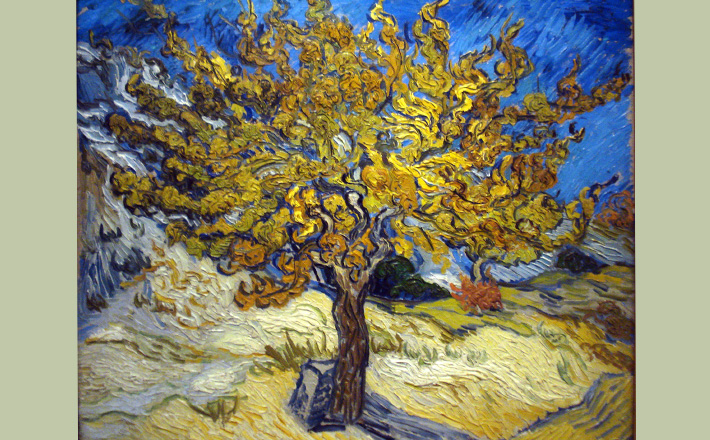Commentary on Luke 17:5-10
How much faith does a person need?
According to the Gospel of Luke, the ones closest to Jesus believe they need more. “Increase our faith!” they plead.
Despite 2000+ years separating their experience from ours, their appeal would be right at home in the up-sizing, bigger-better-more culture of today. It is all too easy to notice what one lacks rather than to recognize gifts already received.
Narrative contexts
Jesus is headed toward Jerusalem, healing and teaching en route. Traveling with him are disciples and apostles (Luke sometimes distinguishes the two). Crowds gather, people seek healing, and challengers seek answers. Occasional literary signposts intensify the long shadow of the cross that hovers over the entire journey (see Luke 9:51; cf. 9:53; 13:22; 17:11; 18:31; 19:28).
Our passage is framed by the parable of the rich man and Lazarus, on one side, and the Samaritan leper who returns to give thanks, on the other. It constitutes the second half of a four-part series of loosely connected teachings related to discipleship, which may be summarized thus: (1) Don’t be the cause of another’s sin (Greek skandalon, stumble); (2) Forgive, again; (3) Miniscule faith is sufficient; (4) Discipleship is not about reward: Just do it!
These are challenging commands — maybe even impossible ones — then and now. It is a sobering thought to recognize one’s capacity to cause another’s stumbling, despite intentions otherwise. Plus, it is hard enough to forgive, even once. But seven times in a single day?! No wonder the apostles ask Jesus for a transfusion of faith (literally “Add faith to us!”).
More faith? Better faith? Any faith at all?
When it comes to faith (Greek pistis, may also be translated as trust, confidence, commitment), Jesus suggests that size does not matter; even a seed of faith holds tree-like potential. Jesus’ followers can live and act on the basis of whatever faith is theirs, no matter how small or insignificant it seems. We might recall that even the immeasurable reign of God is compared to a mustard seed (Luke 13:19).
As commentators note, the Greek grammar of Jesus’ response to the apostles’ request in Luke 17:6 presents difficulties for translation. It is a mixed conditional sentence. The “if” clause is a simple condition (assumed to be true for the sake of argument), while the “then” clause suggests a contrary-to-fact condition (assumed to be untrue for the sake of argument).
Mulberry trees do not routinely replant themselves, in the sea or elsewhere, suggesting that most Jesus-followers have faith even smaller than a mustard seed. So then, is Jesus chastising the apostles for a complete lack of faith? Or, rather, is he encouraging them not to worry about the smallness of their faith? Greek grammar or no, Jesus’ answer seems to be a mixed one.
Mixed faith
Indeed, throughout Luke’s Gospel, the closest followers of Jesus reveal their own “mixed” level of faith. On one hand, they have left homes and jobs and families in order to follow Jesus. It has not been easy, as they have encountered hostility from many who oppose Jesus (Luke 11:53; 13:31; 16:14). Still they have stuck around, even for this final journey toward Jerusalem, and even when they have received a warning of what is to come (Luke 9:22). Similar examples of faith are, no doubt, present in every preacher’s congregation.
At the same time, in our own world’s days of turmoil and fear, we can empathize with the disciples when faith wavers. When the wind roars and the waves batter their boat as they cross the Sea of Galilee, even as Jesus sleeps beside them, they are overwhelmed by terror. “Where is your faith?” Jesus asks, after calming the storm (Luke 8:25). Later, he chides their limited trust in God. “If God clothes the grass … how much more will [God] clothe you — you of little faith!” (Luke 12:28).
Proximity to Jesus does not guarantee unwavering faith.
Faithful examples
Still, examples of faithfulness abound in Luke’s Gospel, suggesting that faith is not defined primarily by cognitive certainty, nor acceptance of proper theological constructs, nor even (necessarily) by people who consider themselves to be closest to Jesus. Faith manifests itself in many ways, by a variety of people.
Faith is persistence in reaching out to Jesus (Luke 5:17-26) and trusting in Jesus’ power and authority (7:1-10). Faith is responding with love to forgiveness received (7:44-50), not letting fear get the upper hand (8:22-25), and being willing to take risks that challenge the status quo (8:43-48). Faith is giving praise to God (17:11-19), having confidence in God’s desire for justice (18:1-8), and being willing to ask Jesus for what we need (18:35-43).1
Preachers can offer comparable examples from their community’s contexts — moments of faithfulness as insignificant as a mustard seed, and as magnificent as if a mulberry tree were to uproot itself and be replanted in the sea.
Jesus closes his four-part teaching moment with a couple of parable-like questions, both of which anticipate a negative answer: “Who among you … ?” and “Do you thank … ?” (Cf. Luke 11:5-7; 15:4).
His teaching draws from the role of a servant (Greek doulos) in the first century agrarian household. Note the similar (but different!) illustration in the parable of the watchful servants (Luke 12:35-38). In that case when the head of the household (Greek kyrios) returns from a wedding banquet, “he will fasten his belt and have them [servants] sit down to eat, and he will come and serve them.” In our passage, Jesus seems to suggest that those who would be leaders (the apostles; note Luke 17:5) would do best to view themselves as ones who serve.2
Instead of worrying about the size of their faith, perhaps these Jesus-followers should just get on with living it out in obedience to Jesus’ commands. After all, we might add, one who is faithful in very little is also faithful in much (Luke 16:10).
Notes:
1 Audrey L. S. West, et. al., New Proclamation: Year C, 2010; Easter through Christ the King, David B. Lott, ed. (Fortress: Minneapolis, 2009), 234.
2 The NRSV uses slave to translate doulos here and most other occurrences in Luke. Among the exceptions are Mary and Simeon, who are called servants (Greek doule, doulos respectively, Luke 1:38; 2:29). The NIV uses servant throughout. I have chosen the latter translation in order to distinguish first century practices from the chattel slavery of the U.S. To be sure, both institutions were oppressive, often horrifyingly so, but there are significant differences between them.


October 2, 2016